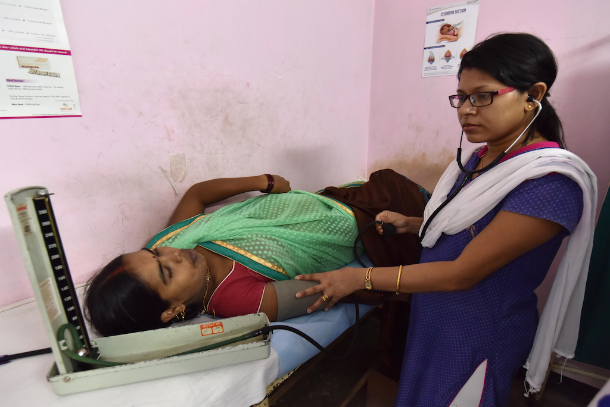
An Indian doctor examines an expectant mother during a health clinic for pregnant women at a hospital in Dhirenpara in Guwahati in this May 2017 file photograph, but many poor Indian women lack access to health services. (Photo by Biju Boro/AFP)
Umar Manzoor Shah, Srinagar
India
January 31, 2019
The snowy night of Jan. 17 was a long one for 36-year-old Suraiya Bano. The pregnant woman, in labor, had been turned away by three hospitals in India’s Jammu and Kashmir state, forcing her to give birth by a roadside.
The baby died a few minutes later in the freezing conditions, her 42-year-old husband Wazir Ahmad said.
Earlier that evening Ahmad had carried his wife on his shoulders along a dark, snow-covered road from their remote Moori hamlet to a hospital three kilometers away. She was complaining of pain.
Doctors asked him to take her to the main Kupwara district hospital and arranged a vehicle. There he was asked to take her to Kashmir’s main maternity hospital in the summer state capital Srinagar, 62 kilometers away.
After six long hours travelling to the maternity hospital, doctors conducted some tests before telling the couple to go home, saying the hospital had no space to accommodate Bano.
“But where can we go and what if something happens to my wife?” Ahmad asked the doctors. But hospital staff kicked the couple out.
“In the freezing cold, we spent the night by a roadside. All of a sudden my wife gave birth to the baby, but moments later it died,” Ahmad said.
Poor Indian women like Bano being denied health care in state-run facilities remains a big concern, according to Srinagar-based social activist Dilshana Andrabi.
“The rich can afford private nursing homes, but where can the poor go?” she asked.
Andrabi told ucanews.com that recent surveys have highlighted how poor women are on the receiving end of pathetic state-run health services.
The latest study was released on Jan. 22 by Oxfam, a confederation of 20 independent charitable organizations focusing on the alleviation of global poverty. It claimed that the poor are denied health care, exposing them to greater risks of lethal diseases.
“When governments reduce their expenditure on essential public services such as education and health care, women and girls are the first ones to lose out on these services,” it said.
Oxfam’s executive director Winnie Byanyima says Indian women and girls from lower castes are the hardest hit by growing economic disparity.
She said the life expectancy of a low-caste woman is almost 15 years less than that of an upper-caste woman as high-quality medical care is only available to those who have the money to pay for it.
The experience of 52-year-old Tara Devi, from a peasant family in Uttar Pradesh, is a case in point. Her pregnant daughter died a year ago because the health care facility in her village was not equipped to conduct a birth by caesarean section.
She had to wait with her daughter for hours to get transport to a hospital. “She died on the way along with her baby. There wasn’t anyone responsible. We could complain to no one,” Devi said.
Marginalized communities
Shamaila Khalil, program coordinator at Oxfam India, told ucanews.com that Dalit women in India die 14.6 years earlier than those of a higher caste. The health system for the poor, especially women from marginalized communities, is a shambles, she said.
“India ranks the third lowest on health on the World Economic Forum’s Gender Gap Index. Instead of investing more in strengthening the health system to ensure every woman has the care that she needs, we have seen a reduction in the health budget for villages, including a dire cut for reproductive and child health,” Khalil said.
India cannot expect to ensure good health care for every woman by spending only 1,112 rupees (US$15) per head per annum, she added.
More needs to be done to provide psychosocial support and care, particularly in cases related to mental health and gender-based violence, Khalil told ucanews.com.
Archbishop Felix Toppo of Ranchi says the Indian government has been doing little to address the emerging health care crisis.
The prelate, who is also a member of the Catholic Bishops’ Conference in India health care commission, told ucanews.com that the government follows a capitalist policy that ignores the poor.
“Corporate houses are being built with full vigor. The country needs a comprehensive health service for the poor, especially women who are falling prey to the negligent attitude of the government,” Archbishop Toppo said.
India’s is the world’s sixth-largest economy with gross domestic product (GDP) of US$2.848 trillion and the third largest by purchasing power parity. However, poverty is so rampant that about 200 million of its 1.2 billion people have no income for a full meal a day, studies show.
Government spending on the welfare of the poor is also too low. For example, according to the latest National Health Profile, India spends a little over one percent of its GDP on health care, which is amongst the lowest in the world.
According to the annual report of the state-run Central Bureau of Health Intelligence, India spends less than Bhutan (2.5 percent), Sri Lanka (1.6 percent) and Nepal (1.1 percent) on health care.
When the poor are neglected, women and girls are the most vulnerable because of Indian society’s general preference for boys to lead families to the next generation, studies show.
Women’s disproportionate poverty, low socioeconomic status, gender discrimination and reproductive role not only expose them to diseases but also limit their access to health services, according to a 2018 research article written by Raju Kowsalya and Shanmugam Manoharan of Annamalai University.
Domestic violence, rape and sexual abuse affect women’s productivity, autonomy, quality of life and physical and mental well-being, the article said.
